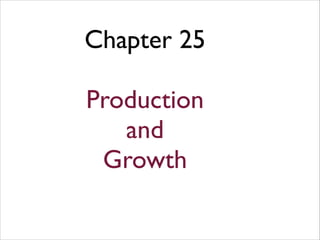
Eco 202 ch 25 production and costs
- 4. Subsidize Petrol? Price Too much and too cheap Supply - Market Supply - Subsidize Pm Ps Qm Qs Demand Quantity
- 5. Profit attracts Innovation Innovation drops cost allowing price to also drop Price Innovation Innovation Innovation Innovation Price Cost Time
- 7. ideas technology methods Intellectual Human trust knowledge skills personality health relationships Entrepreneur money and risk savers and borrowers time is money Culture Financial (1+r)n insurance limited liability corporations Physical natural resources time buildings equipment things than make things
- 9. How do we go from this... to this?
- 10. 1800 Population 2010 one billion seven billion Change 7x Life Expectancy 26 years 66 years 40 + GDP Per Capita Per Day $3 $30 10 x
- 11. GDP Per Capita GDP: $70,000,000,000,000 Population: 7,000,000,000 GDP Per Capita: $10,000 Source: https://www.google.com.sa/publicdata/explore? ds=d5bncppjof8f9_&met_y=ny_gdp_mktp_cd&tdim=true&dl=en&hl=en&q=world%20gdp#! ctype=l&strail=false&bcs=d&nselm=h&met_y=ny_gdp_pcap_cd&scale_y=lin&ind_y=false&rdim=region&ifdim=regi on&tdim=true&hl=en_US&dl=en&ind=false
- 13. Linear versus Exponential Adding versus Compounding 64 64 ^ 56 48 40 32 32 24 16 16 8 0 2 1 + 4 2 8 6 8 3 4 10 5 12 6
- 14. Rule of 70s Years to Double 70 divided by the rate of growth 70 Rate of Growth
- 15. Rate 1% 2% Years to Double 70 ÷ 1 = 70 70 ÷ 2 = 35 Size in 70 years? 2x 4x 3% 70 ÷ 3 = 23.3 8x 4% 5% 70 ÷ 4 = 17.5 70 ÷ 5 = 14 16 x 32 x
- 16. Why do Standards of Living differ? One word ! Productivity
- 18. What is Wealth? What people want
- 19. What is Capital? Anything that helps you create wealth
- 20. Five Types of Capital Cultural Human Physical Intellectual Financial
- 21. Cultural Capital
- 23. Cultural Capital How people view and treat other people ! Expectations
- 24. Cultural Capital Property Rights Rule of Law Political Stability No peace ... No prosperity
- 25. Lady Justice Weight of the evidence versus Status of the parties
- 26. Human Capital
- 27. I look for three things in hiring people. ! The first is personal integrity, the second is intelligence, and the third is a high energy level. ! But of you don’t have the first, the other two will kill you. ! - Warren Buffett, CEO, Berkshire Hathaway
- 29. Human Capital Trust Knowledge and Skills Health and Nutrition Social Relationships
- 31. Physical Capital Two types Tools Natural Resources Water, Oil, Minerals
- 32. Physical Capital Tools we use to make stuff ! Natural Resources Renewable Non-renewable !
- 33. Intellectual Capital Technology How the world works How we make smart things and make things smart
- 34. Research and Development Patent System 20 Year Monopoly on your idea
- 36. Financial Capital Money ! Allows us to store labor and shift time
- 37. Spend or Save? Savings versus Consumption
- 38. Three Steps Save instead of consume Investment in new capital Increase productivity
- 39. Capital Allocation Right capital at the right time
- 42. Education Each year in school adds 10 percent to income ! Invest versus consume
- 43. Population Growth More people Smaller slices GDP GDP per capita Grow the pie faster than population
- 44. Population Growth A smaller slice of a larger pie is bigger than a larger slice of a smaller pie
- 45. How you slice the pie Culture determines the size of the pie !
- 46. U.S. Farmers 1800 - 90 percent 1900 - 45 percent
- 47. U.S. Farmers 2012 - 2 percent
- 48. Productivity Growth More people More ideas More innovation More wealth
- 49. Quiz 1. What are the five types of capital? 2. What is global GDP per capita? 3. If a country is growing at 5 percent, how long will it take to double GDP? 4. What is productivity? 5. Name two types of physical capital.
